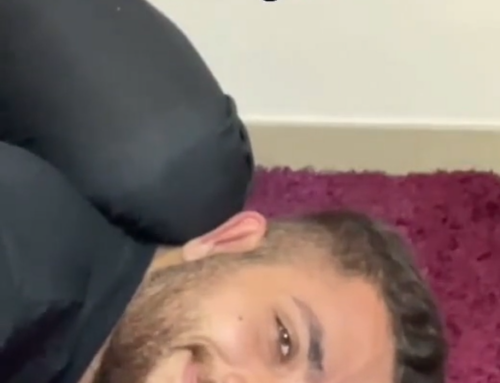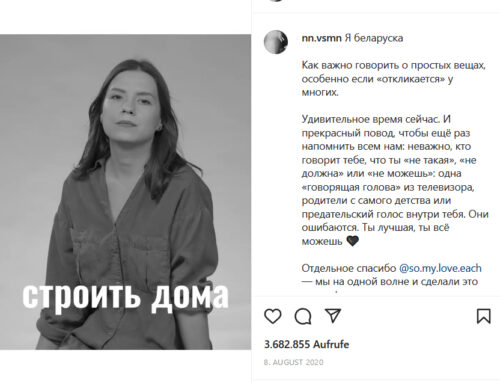A young woman shares her experience of domestic violence on YouTube using the popular ‘One Photo a Day’ format. However, the video only gradually reveals that this is what it is about.
2012 is the worst year in a young woman’s life. Every day she takes a selfie of herself and then combines these photos in chronological order into a short video. Careful make-up, fancy clothes, a slight smile on her lips – she is hardly different from the typical influencer on YouTube. But in the 19th second of the video, which is only 1:19 minutes long in all, a change becomes visible for the first time: a haematoma in the lower part of the face cannot be overseen, the smile disappears. The initially self-confident expression gives way to an increasingly desperate one. Even the places where the pictures are taken hardly vary any more. While in the beginning the young woman still photographs herself in front of changing backgrounds, the space becomes tighter in the course of time. Towards the end, the selfies are taken only in her flat. The signs of abuse and violence become more frequent and obvious: two black eyes, bruises on her cheek, forehead, and chin, a split lip and strangulation marks on her neck. The last picture shows the young woman with serious injuries to her face. She is holding a white paper in her hand, on it a cry for help: ‘POMOZITE MI. NE ZNAM DA LI CU DOCEKATI SUTRA’ (Help me. I don’t know if I will survive until tomorrow).
The title, One Photo a Day in the Worst Year of My Life already points to the special narrative structure of this video. It is based on the widely used, photo-documentary, ‘One Photo a Day’ format. In 2006, the American photographer Noah Kalina shared such a video on YouTube for the first time under the title Everyday; it has been viewed around 26 million times thus far. The reference to the first video in this internet trend is made all the more obvious in that the original music was also adopted: an instrumental piano piece by the pianist Carly Comando. This sustained, emotional background music contrasts with the extreme speed with which the individual images follow one another. The time-lapse editing means that the depiction of a year lasts barely longer than a minute, with the viewers experiencing every single day of the young woman’s life for a moment. The frontal perspective of the picture practically forces them to perceive the face and the traces of abuse precisely. Through the perspective, the face and facial expressions become the focus of attention. In addition to the signs of violence on the young woman’s face, emotional expression is the central means of depicting and conveying the experience of violence.
One Photo a Day in the Worst Year of My Life appeared on YouTube on 18 March 2013 as part of a campaign against domestic violence in Serbia. Within one week the video went viral and generated three million views, rising to more than 62 million (as of 03 September 2020). The special feature: The video was initially just audio-visual narration without any institutional framework – no reference whatsoever to the NGO, Fund B92, which commissioned the video, nor to the globally active advertising agency Saatchi & Saatchi Belgrade, which was responsible for production.
The origin is also obscured by the choice of the distribution channel entitled ‘fero061982’, which has no obvious connection to the campaign against domestic violence in Serbia. The uploaded video is the only one on the channel at this time and thus remains ambivalent in regard to its status as reality or staged. The 9,705 comments (as of 12 June 2019) show a controversy, with the users disagreeing whether the protagonist is a real person sharing her ‘worst year’ with the YouTube users or whether everything is just ‘fake’: she an actress, and the injuries the work of skilled make-up artists. In a kind of forensic search for evidence, users give hints in the comments about ‘mistakes’, such as that the alleged wounds heal too quickly. The central question the recipients asks themselves: Is the video really documentary or fiction?
Ten days after its release (on 28 March 2013), an explanation was provided: a second video was released on the same YouTube channel, retrospectively giving the first one an institutional framework: in Serbian, in plain writing, and again in combination with calm instrumental music, it explains in 29 seconds that every third woman in the world is a victim of abuse. With reference to the address www.sigurnakuca.net (‘Sigurna Kuca’ means ‘security’), it calls for immediate help for women affected by abuse. At that point, the first video can be recognised beyond doubt as part of a campaign against domestic violence. By referring to the website, the recipient is given the opportunity to obtain more detailed information and to react to the appeal.
The strategy of creating insecurity generates interest, curiosity, and consternation, and makes it strikingly clear that every woman can become a victim of violence and abuse – no matter how self-confident and independent she appears. The mutability of the young woman in front of the camera supports this thesis. Her appearance, which changes from picture to picture, with different clothing, accessories, hairstyles, and make-up, represents a whole range of women. This once again shows that domestic violence is independent of the income or social status of those affected. In contrast to these changes, a small birthmark above the mouth of the protagonist acts as an anchor in the rapidly changing images, thus identifying the woman who otherwise would be difficult to recognise due to her serious injuries.
The campaign was awarded nationally and internationally renowned prizes and, through the drastic nature of the images and the insecurity it causes its viewers, achieved its primary goal: to make the topic of domestic violence the subject of attention. The donations received also enabled the NGO Fund B92 to open two more women’s shelters in Serbia.
Merle Bonato



